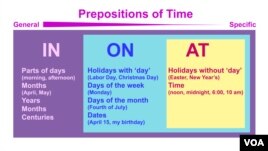When English speakers talk about time and place, there are three little words that often come up: in, on, and at. These common words are prepositions that show a relationship between two words in a sentence.
当讲英语的人谈到时间和地点时经常会出现三个简短的单词:in, on以及at。这些常用词是显示句子中两个单词之间关系的介词。
Some prepositions are rather easy for English learners to understand: behind, over, under, next to, etc...
一些介词对英语学习者来说很容易理解,像behind, over, under ,next to等等。
But these little two-letter prepositions seem to create confusion. Here are a few rules to help you understand when to use in, on, and at in a sentence.
但是这些两个字母组成的介词似乎造成了混淆。以下是一些规则,可以帮助你理解在句子中什么时候用in, on和at。
For describing time and place, the prepositions in, on, and at go from general to specific.
In, on和at这些介词用于描述从一般意义到特定的时间和地点。
Prepositions and Time
介词和时间
Let's start by looking at how we talk about time. English speakers use in to refer to a general, longer period of time, such as months, years, decades, or centuries. For example, we say "in April," "in 2015" or "in the 21st century."
首先让我们来看看如何讨论时间。讲英语者使用in来指代一般意义和一段周期较长的时间。例如几个月,几年,几十年甚至几百年。例如,我们常说“在四月份”,“在2015年”或者“在21世纪”。
Moving to shorter, more specific periods of time, we use on to talk about particular days, dates, and holidays . You may hear, "I went to work on Monday," or "Let's have a picnic on Memorial Day."
当谈到较短,更具体的时间,我们使用on来谈论特定日子和节假日。你可能会听到,“我周一去上班了”或者“让我们在阵亡将日纪念日去野餐。”
For the most specific times, and for holidays without the word "day," we use at. That means you will hear, "Meet me at midnight," or "The flowers are in bloom at Easter time."
对于更具体的时间以及不包含day这个单词的假期,我们使用at。这意味着你将会听到,“午夜见”或者是“这花在复活节期间开放。”
Prepositions and Place
介词和地点
When English speakers refer to a place, we use in for the largest or most general places. You can say that "VOA is located in Washington, D.C." And "for the best food, try the restaurants in Chinatown."
当讲英语者提到一个地方,我们使用in用于最大或最一般意义的地方。你可以说,“美国之音位于华盛顿特区”以及“想吃最好吃的食物去唐人街的餐馆试试。”
For more specific places, like certain streets, we use the preposition on. You may know that President Obama lives on Pennsylvania Avenue in Washington, D.C.
对于更具体的地方,例如具体街道,我们使用介词on。你可能知道,奥巴马总统居住在华盛顿特区的宾夕法尼亚大道。
Finally, we get to the most specific places. For exact addresses or intersections, we use the preposition at. If I invited you to visit us here at VOA, I would say, "Come to my office at 330 Independence Avenue." To be exact, it's at the corner of Independence and 3rd Street."
最后,我们谈到最具体的地方。例如确切地址或十字路口,我们使用介词at。如果我邀请你到美国之音来探访我们,我会说,“到我办公室来,地点在独立大道330号。”更确切的说,它位于独立大道和第三大街的拐角处。
In English, though, there is always an ‘exception to the rule.' When talking about transportation, things get a little hard to understand. We use on for public vehicles like buses or trains, but also for smaller ones like a bicycle. "I rode there on my bicycle." However, you ride in a car.
然而在英语中总会有些例外。当我们谈到交通时,情况就有点难以理解。我们在谈到公交或火车等公共车辆用on,但是谈到较小的交通工具像自行车时也用on。“我骑自行车去那里的。”然而,乘坐小汽车我们说ride in a car。
Still, it helps to know that English prepositions do have some rules.
尽管如此,这有助于大家了解英语介词确实存在一些规则。
Following the "general to specific" rule should help you most of the time.
遵循从一般意义到特定情况的规则大部分时间都能帮到你。
I'm Jill Robbins.
我是吉尔·罗宾斯。(51VOA.COM对本文翻译保留全部权利,未经授权请勿转载,违者必究!)











